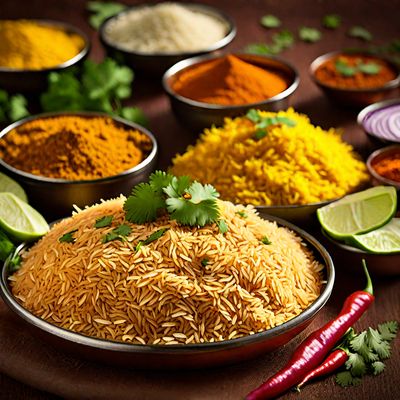
Ingredient
Turmeric roots and similar-
Golden Spice Marvel
Turmeric roots and similar ingredients, such as ginger and galangal, belong to the Zingiberaceae family and are known for their pungent, earthy flavor and bright yellow-orange color. They add depth and complexity to dishes, ranging from curries and stir-fries to teas and desserts.
Origins and history
Turmeric, ginger, and galangal have a long history of cultivation and use in various cuisines. Turmeric, in particular, has been used for thousands of years in traditional Ayurvedic and Chinese medicine for its medicinal properties. These ingredients have also played a significant role in culinary traditions, adding flavor, color, and health benefits to a wide range of dishes.
Nutritional information
Turmeric roots and similar ingredients are rich in antioxidants and bioactive compounds, including curcumin, gingerol, and galangalol. They have been associated with various health benefits, such as reducing inflammation, boosting immunity, and aiding digestion. They are also low in calories and contain essential vitamins and minerals.
Allergens
Turmeric roots and similar ingredients are generally safe for consumption, but some individuals may be allergic or sensitive to them. Allergic reactions are rare but can occur. It is advisable to exercise caution and consult a healthcare professional if you have any known allergies or medical conditions.
How to select
When selecting turmeric roots and similar ingredients, look for firm, unblemished roots with a vibrant color. Avoid roots that are soft, moldy, or have signs of decay. Freshness is key, so choose roots that are plump and have a strong aroma. If possible, opt for organic or locally sourced roots for the best quality and flavor.
Storage recommendations
To prolong the shelf life of turmeric roots and similar ingredients, store them in a cool, dry place away from direct sunlight. You can wrap them in paper towels or store them in a breathable bag to prevent moisture buildup. Avoid refrigerating them, as this can cause them to become soft and lose their flavor.
How to produce
Turmeric, ginger, and galangal can be grown at home by planting the rhizomes in well-draining soil and providing them with adequate sunlight and water. With proper care and patience, these plants can thrive in both indoor and outdoor settings, allowing you to enjoy fresh and flavorful roots.
Preparation tips
Turmeric roots and similar ingredients can be used in various forms, including fresh, dried, powdered, or grated. Fresh roots can be peeled and grated to add a punch of flavor to curries, marinades, and smoothies. Dried and powdered forms are commonly used in spice blends, teas, and baked goods. Experiment with different recipes and techniques to fully explore their versatility.
Substitutions
Ginger can be used as a substitute for turmeric roots, providing a similar warm and slightly spicy flavor. However, it lacks the vibrant color that turmeric imparts. Galangal, on the other hand, can be used as a substitute for ginger, offering a milder and more citrusy flavor. Each ingredient brings its own unique characteristics to dishes, so substitutions may alter the overall taste and appearance.
Culinary uses
Turmeric roots and similar ingredients are widely used in various cuisines around the world. They are essential in Indian curries, Thai stir-fries, Indonesian sambals, and Middle Eastern spice blends. They can be incorporated into soups, stews, marinades, dressings, and even desserts, adding depth, warmth, and a vibrant hue to the dishes.
Availability
Turmeric roots and similar ingredients are commonly available in regions where they are cultivated, such as India, Southeast Asia, and parts of Africa. They can also be found in most grocery stores, supermarkets, and specialty spice shops worldwide due to their popularity and versatility.
More ingredients from this category
Recipes using Turmeric roots and similar-

Vegan Biryani
Plant-Based Delight: Vegan Biryani

Turkish-style Rendang
Sultan's Delight: Turkish Rendang with a Twist

Chicken Tikka Masala
Russian-style Chicken Tikka Masala: A Fusion of Indian and Russian Flavors

Molecular Gastronomy Curry
The Curry of the Future

Fast Food Biryani
Quick and Easy Biryani

Molecular Gastronomy Biryani
Biryani 2.0: A Modern Twist on a Classic Dish

Croatian-style Biryani
Croatian Biryani - A Fusion of Flavors